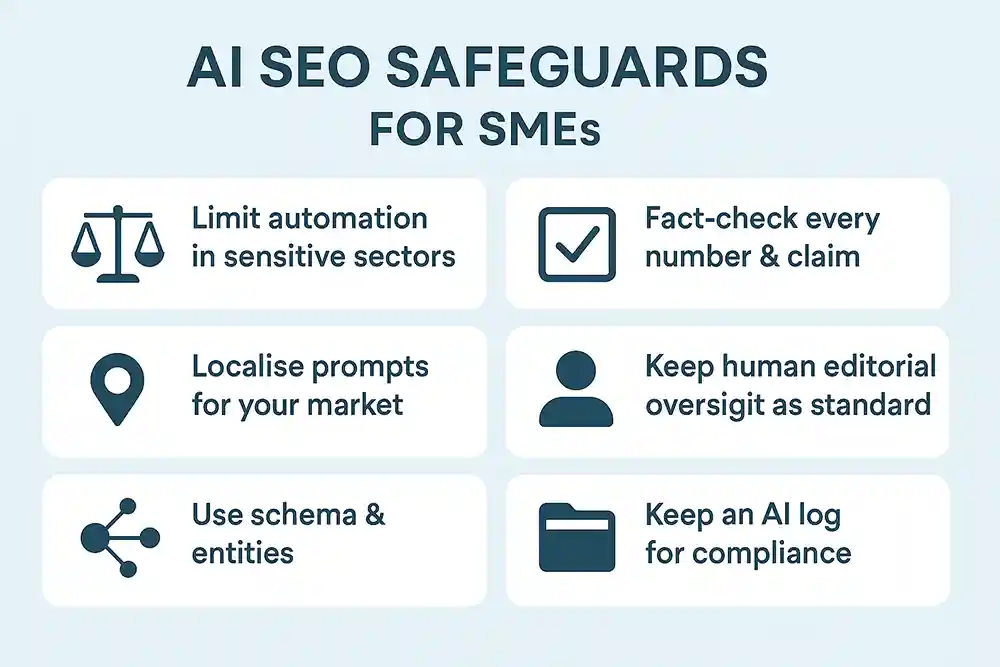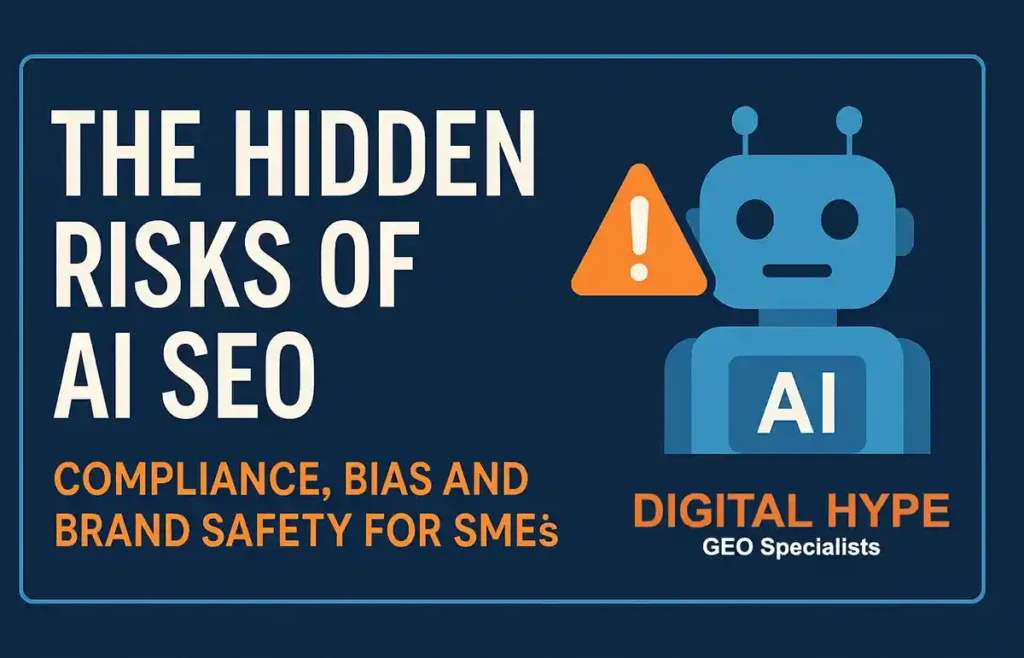A few weeks ago, a local business owner in Dorset called me in a panic. Their Google Search Console was flashing with warnings, and content was being de-indexed. The cause? Their agency had churned out hundreds of AI-written blogs, unedited and unchecked, riddled with compliance issues.
That’s the reality of AI SEO right now. The tools are powerful, but if you think they’ll replace human oversight, you’re gambling with your brand.
AI-assisted SEO can absolutely help SMEs. It speeds up clustering, outlines, and content scaling. However, there are hidden risks that business owners often overlook, including compliance blind spots, machine bias, over-automation, and long-term brand safety. Ignore them, and you risk undoing years of reputation-building in one bad campaign.
Here’s how to spot the traps and put safeguards in place.
Why SMEs Can’t Afford to Get This Wrong
For big brands, a misstep in AI SEO is annoying; for SMEs, it can be fatal. I’ve seen it too many times: a small business invests in “quick-win” tactics, only to find six months later their site visibility has collapsed, enquiries have dried up, and they’re left scrambling to undo the damage.
Budgets are tighter than ever. If you’re running an SME, every pound you spend has to work. You don’t get the luxury of throwing money at mistakes and waiting it out. One poorly planned AI content push can burn through budget without generating a single qualified lead.
Search is shifting faster than most businesses realise. Google’s AI Overviews and generative results are rewriting the rulebook in real time. If your competitors are building content designed to surface in those answers while you’re still playing the old keyword game, you’re not just behind, you’re invisible.
Trust is fragile, and it’s earned slowly but lost quickly. All it takes is one ASA complaint about an overblown claim in an AI-generated blog, and suddenly, your reputation is under scrutiny. For SMEs who rely heavily on local word-of-mouth, a dent in trust isn’t just a blip; it cuts right into sales.
And here’s my honest take: SMEs that get AI SEO wrong aren’t simply risking a dip in rankings. They’re risking the very lifeblood of their business. In today’s environment, visibility is a matter of survival. You can’t afford to treat AI SEO as an experiment — you need a strategy grounded in compliance, trust, and long-term resilience.
Compliance Blind Spots: Where AI Trips You Up
This is the big one. AI doesn’t understand ASA guidelines, CAP codes, GDPR, or industry-specific advertising laws.
I’ve seen AI generate claims like “This product is the safest on the market”. That’s a red flag under UK advertising law. In regulated industries such as finance, healthcare, or legal services, the risks are doubled.
And let’s be clear: regulators don’t care if it was a human or a machine that wrote it. If it breaches rules, it’s on you.
Safeguard: SMEs require a straightforward yet non-negotiable process; every AI-assisted draft must undergo a human compliance check before it goes live. Keep a short checklist:
- Is this claim verifiable?
- Does this wording meet ASA/CAP standards?
- Does it reference sources correctly?
It takes minutes but saves headaches later.
Tip: If you’re handling customer data in content or prompts, GDPR still applies. The Information Commissioner’s Office provides clear guidance for SMEs to make sure personal data isn’t misused or stored without consent.
Bias in AI Outputs: Who Gets Left Behind
Bias is one of those risks most business owners never think about, until it bites. Generative AI isn’t neutral; it’s trained on historic data, which means it tends to reinforce what’s already dominant. For SMEs, that’s a problem.
- Big brands get the spotlight. AI often defaults to the companies with the most significant digital footprints, making it harder for smaller businesses to be noticed.
- US tone creeps in. I’ve lost count of how many drafts were returned with American spelling, cultural references, or phrases that don’t resonate in the UK market.
- Your brand voice gets flattened. AI plays it safe, smoothing out personality, humour, and local quirks that actually make your business stand out.
When I tested prompts for a Bournemouth café, the AI kept suggesting “soda” and “restrooms.” That might fly for a New York deli, but it jars with a Dorset audience and makes you sound inauthentic.
Safeguard: Localise your AI use. Anchor prompts to your market, geography, and brand voice. Use a schema to tie your entity to a town, district, county, or other relevant locations where you conduct business. And don’t skip the human edit. That’s where personality and trust are layered back in.
Over-Automation: The Shortcut That Backfires
Here’s where many SMEs get burned. The temptation is to automate everything, let AI crank out dozens of blogs, and hope volume equals visibility.
It doesn’t!
Google’s spam policies make it crystal clear: content designed for search engines, not people, will not rank. Over-automation leads to:
- Thin, repetitive blogs that fail to index.
- Content that lacks E-E-A-T (Experience, Expertise, Authority, Trust).
- A robotic tone that customers spot a mile away.
My rule is simple: AI for speed, humans for sense. Utilise AI to generate 80% of the scaffolding, including outlines, clustering, and draft copy. However, the final 20% must be human refinement: facts verified, tone adjusted, and compliance confirmed.
Anything less is brand risk, not brand building.
Search Visibility Risks: Losing the Long Game
Here’s a tough pill to swallow: when SMEs lean too hard on AI, they often see a sugar rush of traffic in the short term, then a painful crash. I’ve watched sites climb quickly with mass-produced AI blogs, only to lose visibility a few months later when Google tightens the screws.
Why does this happen?
- AI Overviews are selective. Google surfaces only content that is authoritative, structured, and credible. Generic AI text doesn’t even get a look-in.
- Authority signals are non-negotiable. If your site lacks author bios, schema markup, backlinks, and human expertise cues, pages risk being excluded altogether.
- Entity dilution creeps in. Instead of strengthening your digital footprint, AI floods your site with vague, repetitive content that confuses search engines about what your business actually does.
Think of it this way: AI can help you lay the scaffolding of your digital presence. However, if you don’t add craftsmanship, human authority, structured data, and fact-checked expertise, the building will never stand. Shortcuts now create cracks you’ll be patching for years.
Reputation & Legal Exposure: The Silent Killer
Search rankings can be recovered. Reputation? Not so easily. This is the risk that keeps me up at night for SMEs dabbling with unchecked AI.
AI doesn’t know your legal boundaries, and it certainly doesn’t care about UK advertising codes. I’ve seen raw drafts that:
- Invent statistics with no sources attached.
- Misquote regulations in ways that could mislead customers.
- Name competitors directly, opening the door to liability.
For an SME, even one misleading claim can spark a customer complaint, an ASA investigation, or worse, legal action. And unlike a dip in rankings, a dented reputation spreads quickly in local markets. It sticks.
Safeguard: Keep an AI content log. Record what was generated, what was fact-checked, and what was published. That log becomes your paper trail, proof that you exercised due diligence. In a world where regulators are sharpening their focus on AI, demonstrating responsibility can make the difference between a warning and a sanction.
My advice? Don’t roll the dice. Reputational damage costs far more to repair than the time it takes to fact-check.
Practical Safeguards Every SME Can Apply
Let’s get practical. It’s easy to talk about “balance” and “oversight,” but what does that actually mean for a small or medium-sized business trying to use AI SEO responsibly?
Think of these safeguards less like a checklist and more like everyday habits. Build them into your process and they’ll soon feel second nature.
1. Be selective about where you automate.
Not all sectors are equal in terms of risk. If you’re in finance, health, or law, regulators are watching closely. AI can still assist with brainstorming or research prompts, but the final decision should always be made by a qualified professional. In less sensitive industries, you’ve got more freedom, but oversight still matters.
2. Treat numbers as guilty until proven innocent.
I can’t stress this enough: fact-check every statistic, percentage, and “fact” AI gives you. If it can’t be traced back to a reliable source, leave it out. An incorrect figure in a blog post isn’t just sloppy; it can land you with a credibility problem or even a complaint.
3. Speak in your own market’s voice.
I’ve seen AI default to Americanisms, “soda,” “restroom,” “color”, that jar with UK readers. SMEs in the UK need to localise prompts and check tone. If your customers wouldn’t say it, neither should your content.
4. Never skip the human touch.
AI can draft, cluster, or outline, but humans must do the polishing. That’s where compliance, brand voice, and personality come in. Without it, you risk flooding your site with “bland soup” content that no one trusts.
5. Strengthen your credibility with structure.
Schema markup, author bios, and entity signals aren’t just technical SEO tricks; they’re what tell Google (and your customers) that you’re legitimate. Think of them as your digital paperwork. Without them, your content looks rootless.
6. Keep an AI content log.
This sounds dull, but it’s one of the most powerful safeguards you can have. Just keep a simple record of what was generated, who reviewed it, and when it went live. If regulators or customers ever question you, you can show evidence of oversight. That level of accountability will become increasingly important as AI use comes under scrutiny.

FAQs: Protecting Your Business When Using AI SEO
Is AI-generated content allowed by Google?
Yes — but only if it’s useful, original, and demonstrates authority. Google’s own guidance makes it clear: the issue isn’t whether content is written by AI, but whether it provides real value. Businesses that flood their site with generic, unedited AI text risk penalties or de-indexation.
How do I stop AI content from sounding robotic?
Always apply a human editorial pass. That means checking tone, localising language, adding examples from your own business, and layering in lived expertise. AI can build a draft, but only humans can inject authenticity and trust.
What compliance rules should SMEs watch when using AI SEO?
In the UK, the ASA, CAP Codes, and GDPR are the big three. Avoid exaggerated claims (“the best,” “guaranteed”), never publish unverifiable statistics, and make sure customer data is handled correctly. If you’re in finance, health, or legal sectors, add stricter checks before publishing.
Can AI SEO help my local business in Bournemouth or Dorset?
Yes, but only if prompts and editing are localised. AI often defaults to US terms and tone. You’ll need to tailor outputs with UK spelling, local references, and schema markup that ties your brand to Bournemouth, Poole, and Dorset to reinforce local authority.
What’s the safest way to scale content with AI?
Follow the 80/20 rule: let AI handle 80% of the groundwork (clustering, outlines, drafts), and dedicate 20% to human oversight (compliance checks, brand tone, fact verification). This keeps output scalable without sacrificing trust.
Could AI SEO damage my reputation?
Yes. If unchecked, AI can generate misleading claims, incorrect statistics, or even competitor comparisons that expose you legally. For SMEs, one reputational hit in a local market can be devastating. Protect yourself by reviewing content carefully and keeping a record of AI outputs.
How do I prove I’m using AI responsibly if regulators ask?
Keep an AI content log. This can be as simple as a spreadsheet recording what AI generated, what was fact-checked, and who approved it. If questioned, you can demonstrate due diligence, and that’s a powerful defence against regulatory complaints.
Will regulators tighten rules around AI SEO in future?
Almost certainly. The EU AI Act is already setting standards, and UK regulators are preparing their own guidance. It’s wise to assume that AI use in marketing will be monitored more closely in the next 12–24 months. SMEs who prepare now will avoid costly adjustments later.
Looking Ahead: Why Balance Wins
Regulators aren’t standing still. The EU AI Act is already setting guardrails, and UK regulators will likely follow suit. My prediction? Within two years, SMEs will be required to demonstrate an “AI policy” as part of their compliance or due diligence obligations. Those who prepare now will glide through; those who don’t will be firefighting.
The winners will be SMEs who blend AI efficiency with human oversight. That’s the sweet spot: you scale content responsibly, protect your brand, and build long-term visibility.
Ready to Harness AI SEO Without the Risks?
If you’re an SME in Bournemouth, Poole, Dorset or anywhere in the UK, the real question isn’t “should we use AI SEO?” — it’s “how do we use it safely, without risking our brand?”
That’s exactly what we help with at Digital Hype. Our approach blends:
- ✔ Generative optimisation that scales responsibly
- ✔ Compliance checks to keep you ASA & GDPR safe
- ✔ Human-led authority and trust signals
Because in the end, search visibility without trust is worthless.
Explore Our Generative Optimisation (GEO) Services

